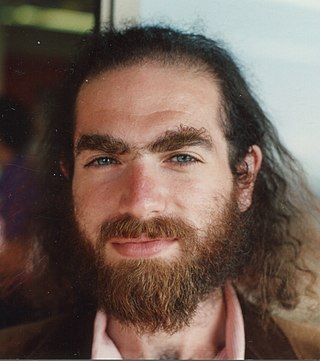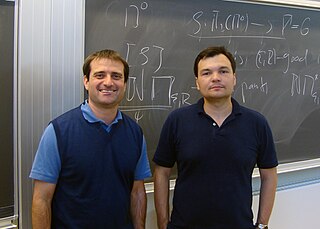In mathematics, Thurston's geometrization conjecture states that each of certain three-dimensional topological spaces has a unique geometric structure that can be associated with it. It is an analogue of the uniformization theorem for two-dimensional surfaces, which states that every simply connected Riemann surface can be given one of three geometries . In three dimensions, it is not always possible to assign a single geometry to a whole topological space. Instead, the geometrization conjecture states that every closed 3-manifold can be decomposed in a canonical way into pieces that each have one of eight types of geometric structure. The conjecture was proposed by William Thurston, and implies several other conjectures, such as the Poincaré conjecture and Thurston's elliptization conjecture.

Grigori Yakovlevich Perelman is a Russian mathematician who is known for his contributions to the fields of geometric analysis, Riemannian geometry, and geometric topology. In 2005, Perelman abruptly quit his research job at the Steklov Institute of Mathematics, and in 2006 stated that he had quit professional mathematics, due to feeling disappointed over the ethical standards in the field. He lives in seclusion in Saint Petersburg, and has not accepted offers for interviews since 2006.

In mathematics, a 3-manifold is a topological space that locally looks like a three-dimensional Euclidean space. A 3-manifold can be thought of as a possible shape of the universe. Just as a sphere looks like a plane to a small and close enough observer, all 3-manifolds look like our universe does to a small enough observer. This is made more precise in the definition below.
In mathematics, more precisely in topology and differential geometry, a hyperbolic 3-manifold is a manifold of dimension 3 equipped with a hyperbolic metric, that is a Riemannian metric which has all its sectional curvatures equal to −1. It is generally required that this metric be also complete: in this case the manifold can be realised as a quotient of the 3-dimensional hyperbolic space by a discrete group of isometries.
In the mathematical subfield of 3-manifolds, the virtually fibered conjecture, formulated by American mathematician William Thurston, states that every closed, irreducible, atoroidal 3-manifold with infinite fundamental group has a finite cover which is a surface bundle over the circle.

Ciprian Manolescu is a Romanian-American mathematician, working in gauge theory, symplectic geometry, and low-dimensional topology. He is currently a professor of mathematics at Stanford University.

In mathematics, the surface subgroup conjecture of Friedhelm Waldhausen states that the fundamental group of every closed, irreducible 3-manifold with infinite fundamental group has a surface subgroup. By "surface subgroup" we mean the fundamental group of a closed surface not the 2-sphere. This problem is listed as Problem 3.75 in Robion Kirby's problem list.
In mathematics, the tameness theorem states that every complete hyperbolic 3-manifold with finitely generated fundamental group is topologically tame, in other words homeomorphic to the interior of a compact 3-manifold.
In topology, an area of mathematics, the virtually Haken conjecture states that every compact, orientable, irreducible three-dimensional manifold with infinite fundamental group is virtually Haken. That is, it has a finite cover that is a Haken manifold.

Vladimir Marković is a Professor of Mathematics at University of Oxford. He was previously the John D. MacArthur Professor at the California Institute of Technology (2013–2020) and Sadleirian Professor of Pure Mathematics at the University of Cambridge (2013–2014).
William Philip Minicozzi II is an American mathematician. He was born in Bryn Mawr, Pennsylvania, in 1967.
In hyperbolic geometry, the ending lamination theorem, originally conjectured by William Thurston, states that hyperbolic 3-manifolds with finitely generated fundamental groups are determined by their topology together with certain "end invariants", which are geodesic laminations on some surfaces in the boundary of the manifold.
In the mathematical theory of Kleinian groups, the density conjecture of Lipman Bers, Dennis Sullivan, and William Thurston, later proved independently by Namazi & Souto (2012) and Ohshika (2011), states that every finitely generated Kleinian group is an algebraic limit of geometrically finite Kleinian groups.

In mathematics, the Ehrenpreis conjecture of Leon Ehrenpreis states that for any K greater than 1, any two closed Riemann surfaces of genus at least 2 have finite-degree covers which are K-quasiconformal: that is, the covers are arbitrarily close in the Teichmüller metric.
In differential geometry the theorem of the three geodesics, also known as Lyusternik–Schnirelmann theorem, states that every Riemannian manifold with the topology of a sphere has at least three simple closed geodesics. The result can also be extended to quasigeodesics on a convex polyhedron, and to closed geodesics of reversible Finsler 2-spheres. The theorem is sharp: although every Riemannian 2-sphere contains infinitely many distinct closed geodesics, only three of them are guaranteed to have no self-intersections. For example, by a result of Morse if the lengths of three principal axes of an ellipsoid are distinct, but sufficiently close to each other, then the ellipsoid has only three simple closed geodesics.
In mathematics, the curve complex is a simplicial complex C(S) associated to a finite-type surface S, which encodes the combinatorics of simple closed curves on S. The curve complex turned out to be a fundamental tool in the study of the geometry of the Teichmüller space, of mapping class groups and of Kleinian groups. It was introduced by W.J.Harvey in 1978.

Francis Bonahon is a French mathematician, specializing in low-dimensional topology.
Albert Marden is an American mathematician, specializing in complex analysis and hyperbolic geometry.
Arthur Bartels is a German mathematician.






